Going Inside a Historical Brazilian Diamond from the Spada Collection (19th Century)
Abstract
:1. Introduction
2. Materials and Methods
2.1. X-ray Diffraction Topography (XRDT)
2.2. Micro-Computed X-ray Tomography Analysis (µ-CXRT)
2.3. Micro-X-ray Diffraction (µ-XRD)
2.4. Fourier-Transform Infrared Spectroscopy (FT-IR)
3. Results
4. Discussion
5. Conclusions
Supplementary Materials
Author Contributions
Funding
Informed Consent Statement
Data Availability Statement
Acknowledgments
Conflicts of Interest
References
- Nestola, F.; Pamato, M.G.; Novella, D. Going Inside a Diamond. In Celebrating the International Year of Mineralogy; Bindi, L., Cruciani, G., Eds.; Springer Mineralogy; Springer: Cham, Switzerland, 2023. [Google Scholar] [CrossRef]
- Nestola, F.; Korolev, N.; Kopylova, M.; Rotiroti, N.; Pearson, D.G.; Pamato, M.G.; Alvaro, M.; Peruzzo, L.; Gurney, J.J.; Moore, A.E.; et al. CaSiO3 perovskite in diamond indicates the recycling of oceanic crust into the lower mantle. Nature 2018, 555, 237–241. [Google Scholar] [CrossRef]
- Stachel, T.; Brey, G.P.; Harris, J.W. Inclusions in Sublithospheric Diamonds; Glimpses of Deep Earth. Elements 2005, 1, 73–78. [Google Scholar] [CrossRef]
- Stachel, T.; Aulbach, S.; Harris, J.W. Mineral inclusions in lithospheric diamonds. Rev. Mineral. Geochem. 2022, 88, 307–392. [Google Scholar] [CrossRef]
- Anzolini, C.; Nestola, F.; Mazzucchelli, M.L.; Alvaro, M.; Nimis, P.; Gianese, A.; Morganti, S.; Marone, F.; Campione, M.; Hutchison, M.T.; et al. Depth of Diamond Formation Obtained from Single Periclase Inclusions. Geology 2019, 47, 219–222. [Google Scholar] [CrossRef]
- Shirey, S.B.; Cartigny, P.; Frost, D.J.; Keshav, S.; Nestola, F.; Nimis, P.; Pearson, D.G.; Sobolev, N.V.; Walter, M.J. Diamonds and the Geology of Mantle Carbon. Rev. Mineral. Geochem. 2013, 75, 355–421. [Google Scholar] [CrossRef]
- Nestola, F.; Regier, M.E.; Luth, R.W.; Pearson, D.G.; Stachel, T.; McCammon, C.; Wenz, M.D.; Jacobsen, S.D.; Anzolini, C.; Bindi, L.; et al. Extreme redox variations in a superdeep diamond from a subducted slab. Nature 2023, 613, 85–89. [Google Scholar] [CrossRef]
- Gu, T.; Pamato, M.G.; Novella, D.; Alvaro, M.; Fournelle, J.; Brenker, F.E.; Wang, W.; Nestola, F. Hydrous peridotitic fragments of Earth’s mantle 660 km discontinuity sampled by a diamond. Nat. Geosci. 2022, 15, 950–954. [Google Scholar] [CrossRef]
- Harris, J.W.; Smit, K.V.; Fedortchouk, Y.; Moore, M. Morphology of Monocrystalline Diamond and its Inclusions. Rev. Mineral. Geochem. 2022, 88, 119–166. [Google Scholar] [CrossRef]
- Agrosì, G.; Tempesta, G.; Mele, D.; Caggiani, M.C.; Mangone, A.; Della Ventura, G.; Cestelli-Guidi, M.; Allegretta, I.; Hutchison, M.T.; Nimis, P.; et al. Multiphase inclusions associated with residual carbonate in a transition zone diamond from Juina (Brazil). Lithos 2019, 350–351, 105279. [Google Scholar] [CrossRef]
- Nimis, P.; Nestola, F.; Schiazza, M.; Reali, R.; Agrosì, G.; Mele, D.; Tempesta, G.; Howell, D.; Hutchison, M.T.; Spiess, R. Fe-rich ferropericlase and magnesiowüstite inclusions reflecting diamond formation rather than ambient mantle. Geology 2019, 47, 27–30. [Google Scholar] [CrossRef]
- Agrosì, G.; Nestola, F.; Tempesta, G.; Bruno, M.; Scandale, E.; Harris, J. X-Ray Topographic Study of a Diamond from Udachnaya: Implications for the Genetic Nature of Inclusions. Lithos 2016, 248–251, 153–159. [Google Scholar] [CrossRef]
- Moore, M. Imaging diamond with x-rays. J. Physiscs Condens. Matter 2009, 21, 364217. [Google Scholar] [CrossRef] [PubMed]
- Agrosì, G.; Tempesta, G.; Della Ventura, G.C.; Cestelli Guidi, M.A.; Hutchison, M.T.; Nimis, P.; Nestola, F. Non-destructive in situ study of plastic deformations in diamonds: X-ray Diffraction Topography and µFT-IR mapping of two super deep diamond crystals from Sao Luiz (Juina, Brazil). Crystals 2017, 7, 233. [Google Scholar] [CrossRef]
- Agrosì, G.; Tempesta, G.; Mele, D.; Allegretta, I.; Terzano, R.; Shirey, S.B.; Pearson, G.; Nestola, F. Non-destructive, multi-method, internal analysis of multiple inclusions in a single diamond: First occurrence of mackinawite (Fe,Ni)1+xS. Am. Mineral. 2017, 102, 2235–2243. [Google Scholar] [CrossRef]
- Lang, A.R. Causes of birefringence in diamond. Nature 1967, 213, 248–251. [Google Scholar] [CrossRef]
- Agrosì, G.; Tempesta, G.; Scandale, E.; Harris, J.W. Growth and post-growth defects of a diamond from Finsch mine (South Africa). Eur. J. Mineral. 2013, 25, 551–559. [Google Scholar] [CrossRef]
- Angel, R.J.; Alvaro, M.; Nestola, F. Crystallographic methods for non-destructive characterization of mineral inclusions in diamonds. Rev. Mineral. Geochem. 2022, 88, 257–305. [Google Scholar] [CrossRef]
- Authier, A.; Zarka, A. X-ray topographic study of the real structure of minerals. In Composition, Structure and Properties of Mineral Matter; Marfunin, A.S., Ed.; Springer: Berlin/Heidelberg, Germany, 1994; pp. 221–233. [Google Scholar]
- Cnudde, V.; Boone, M.N. High-resolution X-ray computed tomography in geosciences: A review of the current technology and applications. Earth-Sci. Rev. 2013, 123, 1–17. [Google Scholar] [CrossRef]
- Nestola, F.; Merli, M.; Nimis, P.; Parisatto, M.; Kopylova, M.; De Stefano, A.; Longo, M.; Ziberna, L.; Manghnani, M. In situ analysis of garnet inclusion in diamond using single-crystal X-ray diffraction and X-ray micro-tomography. Eur. J. Mineral. 2012, 24, 599–606. [Google Scholar] [CrossRef]
- Nestola, F.; Nimis, P.; Ziberna, L.; Longo, M.; Marzoli, A.; Harris, J.W.; Manghnani, M.H.; Fedortchouk, Y. First crystal-structure determination of olivine in diamond: Composition and implications for provenance in the Earth’s mantle. Earth Planet. Sci. Lett. 2011, 305, 249–255. [Google Scholar] [CrossRef]
- Breeding, C.M.; Shigley, J.E. The “Type” Classification System of Diamonds and Its Importance in Gemology. Gems Gemol. 2009, 45, 96–111. [Google Scholar] [CrossRef]
- Woods, G.S.; Collins, A.T. Infrared absorption spectra of hydrogen complexes in type I diamonds. J. Phys. Chem. Solids 1983, 44, 471–475. [Google Scholar] [CrossRef]
- Woods, G.S. Platelets and the infrared Absorption of Type Ia Diamonds. Proc. R. Soc. London Ser. A 1986, 407, 219–238. [Google Scholar] [CrossRef]
- Zaitsev, A.M.; Prelas, M. Handbook of Industrial Diamonds and Diamond Films; Prelas, M., Popovici, G., Bigelow, L., Eds.; Dekker: New York, NY, USA, 1998; pp. 227–376. [Google Scholar]
- Woods, G.S.; Purser, G.C.; Mtimkulu, A.S.S.; Collins, A.T. The nitrogen content of Type Ia natural diamonds. J. Phys. Chem. Solids 1990, 51, 1191–1197. [Google Scholar] [CrossRef]
- Boyd, S.R.; Kiflawi, I.; Woods, G.S. Infrared absorption by the B nitrogen aggregate in diamond. Philos. Mag. B 1995, 72, 351–361. [Google Scholar] [CrossRef]
- Collins, A.T. Vacancy enhanced aggregation of nitrogen in diamond. J. Phys. C Solid St. Phys. 1980, 13, 2641–2650. [Google Scholar] [CrossRef]
- Zaitsev, A.M. Optical Properties of Diamond: A Data Handbook; Springer: Berlin/Heidelberg, Germany, 2001; p. 502. [Google Scholar]
- Kaminsky, F.V.; Khachatryan, G.K. Characteristics of nitrogen and other impurities in diamond, as revealed by infrared absorption data. Can. Mineral. 2001, 39, 1733–1745. [Google Scholar] [CrossRef]
- Klapper, H. Generation and propagation of dislocations during crystal growth. Mater. Chem. Phys. 2000, 66, 101–109. [Google Scholar] [CrossRef]
- Diehl, R.; Herres, N. X-ray fingerprinting routine for cut diamonds. Gems Gemol. 2004, 40, 40–57. [Google Scholar] [CrossRef]
- Titkov, S.V.; Krivovichev, S.V.; Organova, N.I. Plastic deformation of natural diamonds by twinning: Evidence from X-ray diffraction studies. Mineral. Mag. 2012, 76, 143–149. [Google Scholar] [CrossRef]
- Wang, Y.; Nestola, F.; Li, H.; Hou, Z.; Lorenzetti, A.; Antignani, P.; Cornale, P.; Nava, J.; Dong, G.; Qu, K. In Situ Single-Crystal X-ray Diffraction of olivine inclusion in Diamond from Shandong, China: Implications for the Depth of Diamond Formation. Eur. J. Mineral. 2023, 35, 361–372. [Google Scholar] [CrossRef]
- Day, M.C.; Pamato, M.G.; Novella, D.; Nestola, F. Imperfections in natural diamond: The key to understanding diamond genesis and the mantle. Riv. Nuovo Cim. 2023, 46, 381–471. [Google Scholar] [CrossRef]
- Nasdala, L.; Grambole, D.; Wildner, M.; Gigler, A.; Hainschwang, T.; Zaitsev, A.; Harris, J.W.; Milledge, J.; Schulze, D.J.; Hofmeister, W.; et al. Radio-colouration of diamond: A spectroscopic study. Contrib. Mineral. Petrol. 2013, 165, 843–861. [Google Scholar] [CrossRef]
- Vance, E.R.; Milledge, H.J. Natural and laboratory α-particle irradiation of diamond. Mineral. Mag. 1972, 38, 878–881. [Google Scholar] [CrossRef]
- Hoal, K.O. The Occurrence of Diamonds in South Africa.: M.G.C. Wilson, N. McKenna and M.D. Lynn, with contributions by T.R. Marshall and A. van der Westhuizen. 2007. Pp. 105, South Africa Council for Geoscience, Mineral Resources Series 1. ISBN 978-1-920226-00-8. Econ. Geol. 2008, 103, 1380. [Google Scholar] [CrossRef]
- Svisero, D.P.; Shigley, J.E.; Weldon, R. Brazilian diamonds: A historical and recent perspective. Gems Gemol. 2017, 53, 2–33. [Google Scholar] [CrossRef]
- Karfunkel, J.; Hoover, D.; Fonseca Fernandes, A.; Sgarbi, G.N.; Kambrock, C.K.; Oliveira, G.D. Diamonds from the Coromandel Area, West Minas Gerais State, Brazil: An update and new data on surface sources and origin. Braz. J. Geol. 2014, 44, 325–338. [Google Scholar] [CrossRef]
- Svisero, D.P. Distribution and origin of diamonds in Brazil: An overview. J. Geodyn. 1995, 20, 493–514. [Google Scholar] [CrossRef]
- de Carvalho, L.D.V.; Schnellrath, J.; Medeiros, S.R.d. Mineral inclusions in diamonds from Chapada Diamantina, Bahia, Brazil: A Raman spectroscopic characterization. REM-Int. Eng. J. 2018, 71, 27–35. [Google Scholar] [CrossRef]
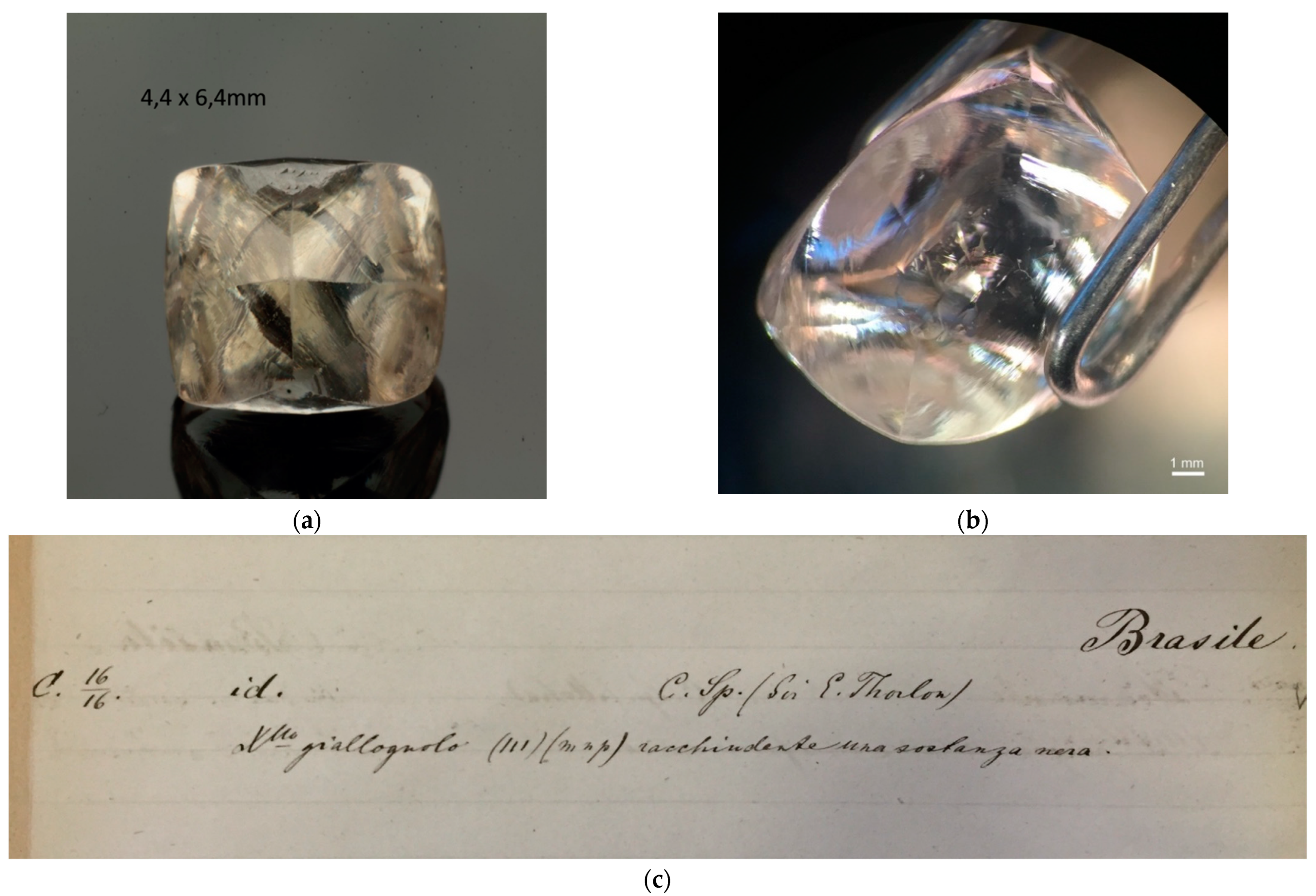
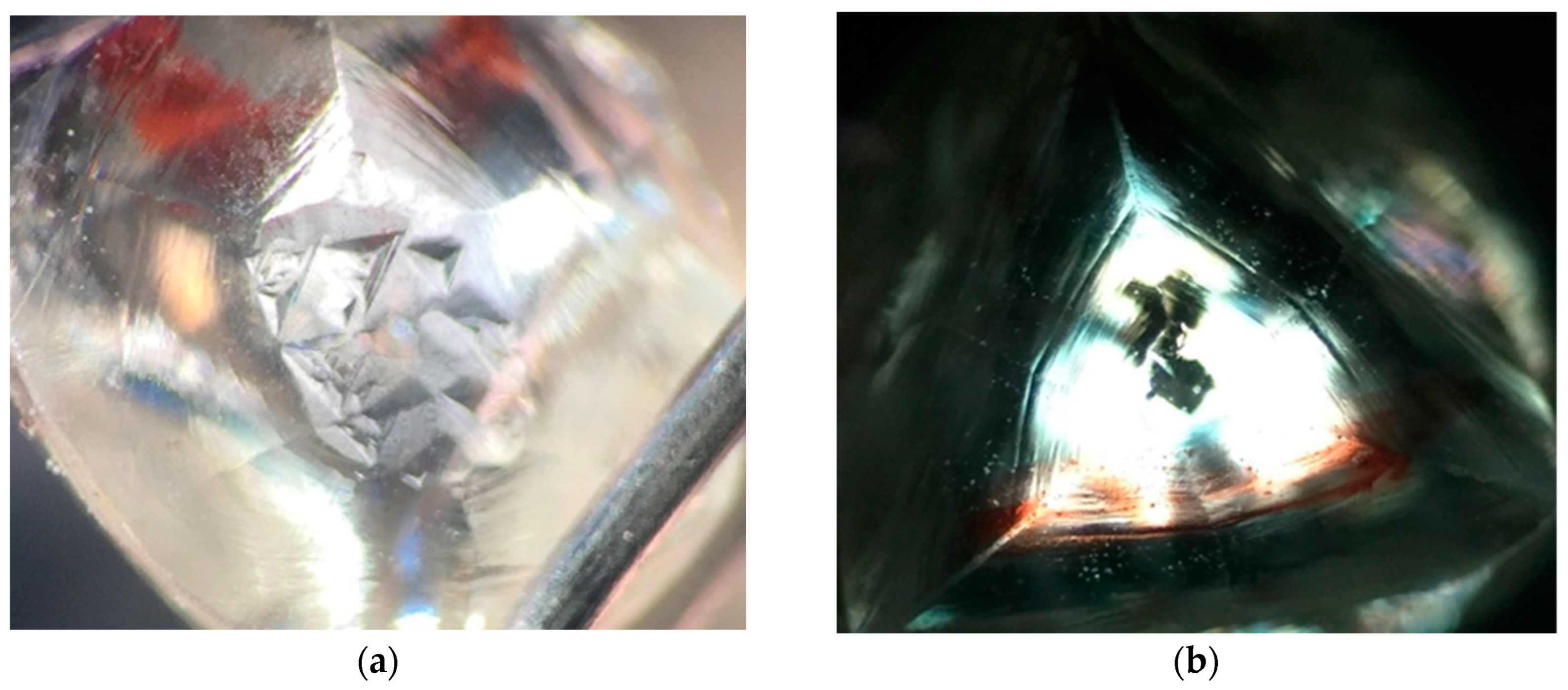
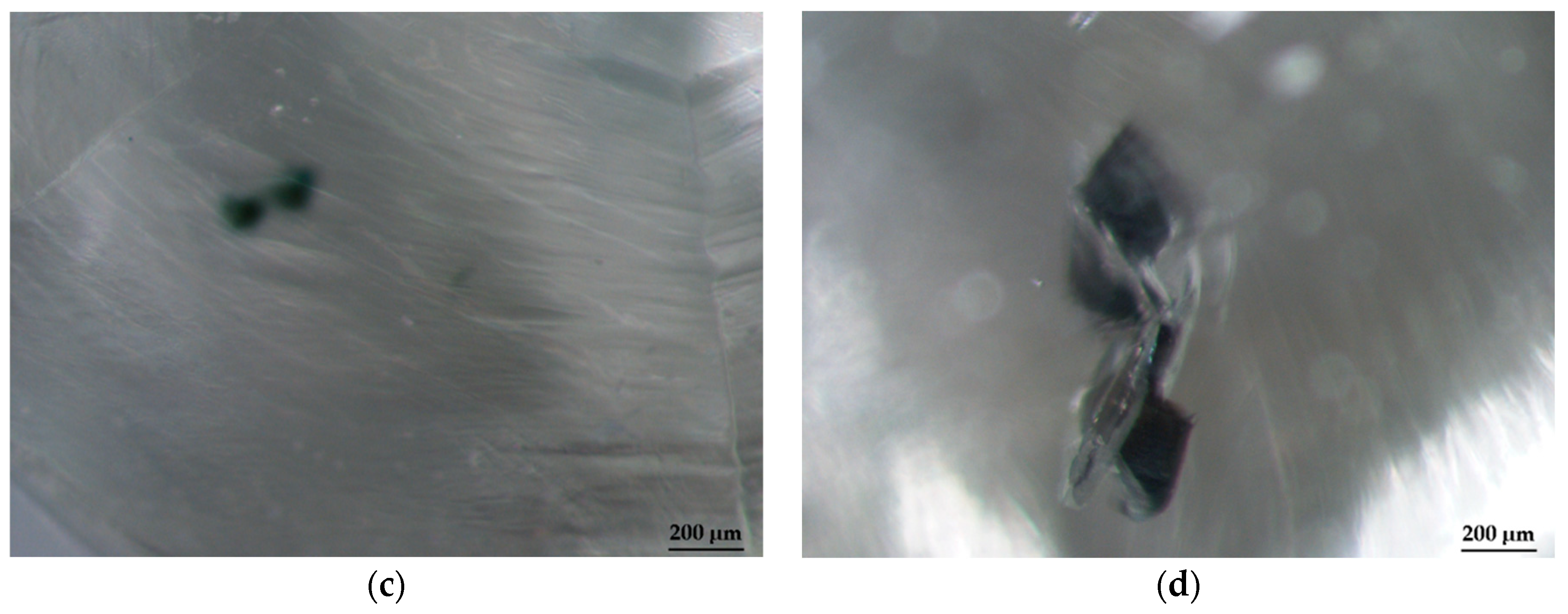
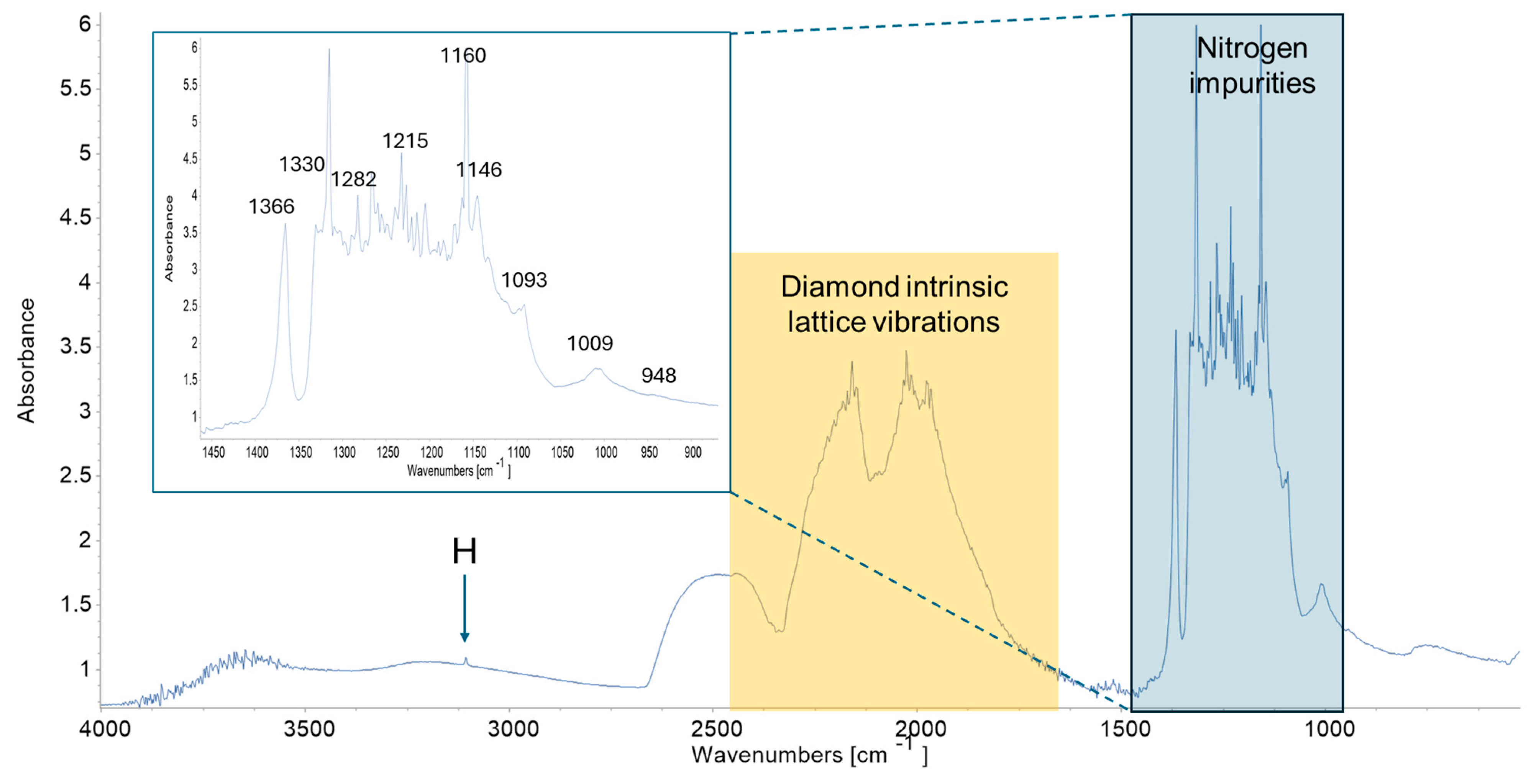
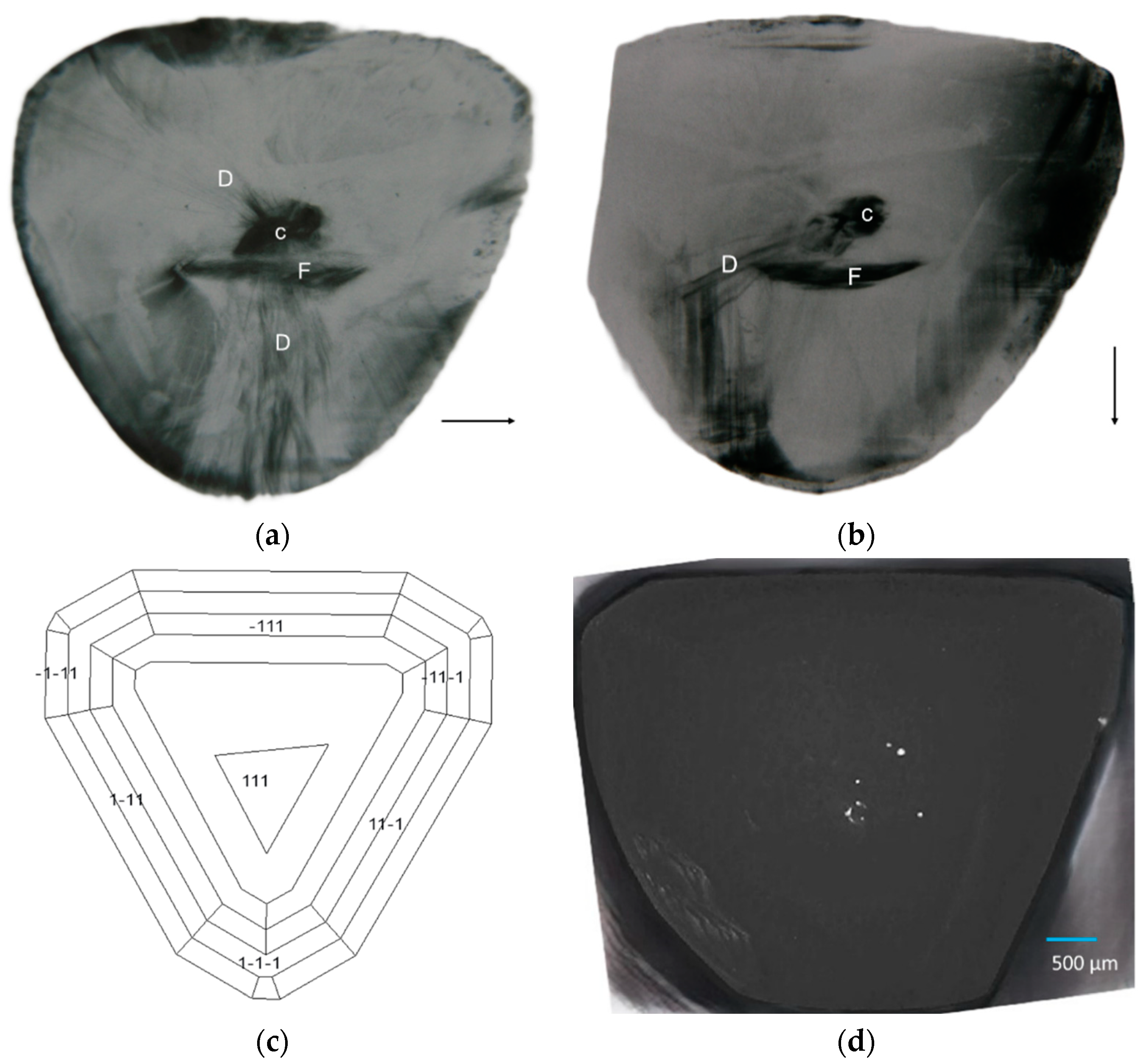
| Peak Position cm−1 | Defect Center | References |
|---|---|---|
| 3107 | H | Woods and Collins (1983) [24] |
| 1366 | B’ or Platelets | Woods (1986) [25] |
| 1330 | B | Zaitsev (1998) [26] |
| 1282 | A | Woods et al. (1990) [27] |
| 1215 | A | Woods (1986) [25] |
| 1160 | B | Woods (1986) [25] |
| 1146 | Dislocations | Boyd et al. (1995) [28] |
| 1130 | C | Collins (1980) [29] |
| 1093 | A and B | Zaitsev (2001) [30] |
| 1009 | B | Woods (1986) [25] |
| 948 | Radiation damage | Zaitsev (2001) [30] |
Disclaimer/Publisher’s Note: The statements, opinions and data contained in all publications are solely those of the individual author(s) and contributor(s) and not of MDPI and/or the editor(s). MDPI and/or the editor(s) disclaim responsibility for any injury to people or property resulting from any ideas, methods, instructions or products referred to in the content. |
© 2024 by the authors. Licensee MDPI, Basel, Switzerland. This article is an open access article distributed under the terms and conditions of the Creative Commons Attribution (CC BY) license (https://creativecommons.org/licenses/by/4.0/).
Share and Cite
Agrosì, G.; Mele, D.; Tempesta, G. Going Inside a Historical Brazilian Diamond from the Spada Collection (19th Century). Crystals 2024, 14, 779. https://doi.org/10.3390/cryst14090779
Agrosì G, Mele D, Tempesta G. Going Inside a Historical Brazilian Diamond from the Spada Collection (19th Century). Crystals. 2024; 14(9):779. https://doi.org/10.3390/cryst14090779
Chicago/Turabian StyleAgrosì, Giovanna, Daniela Mele, and Gioacchino Tempesta. 2024. "Going Inside a Historical Brazilian Diamond from the Spada Collection (19th Century)" Crystals 14, no. 9: 779. https://doi.org/10.3390/cryst14090779







